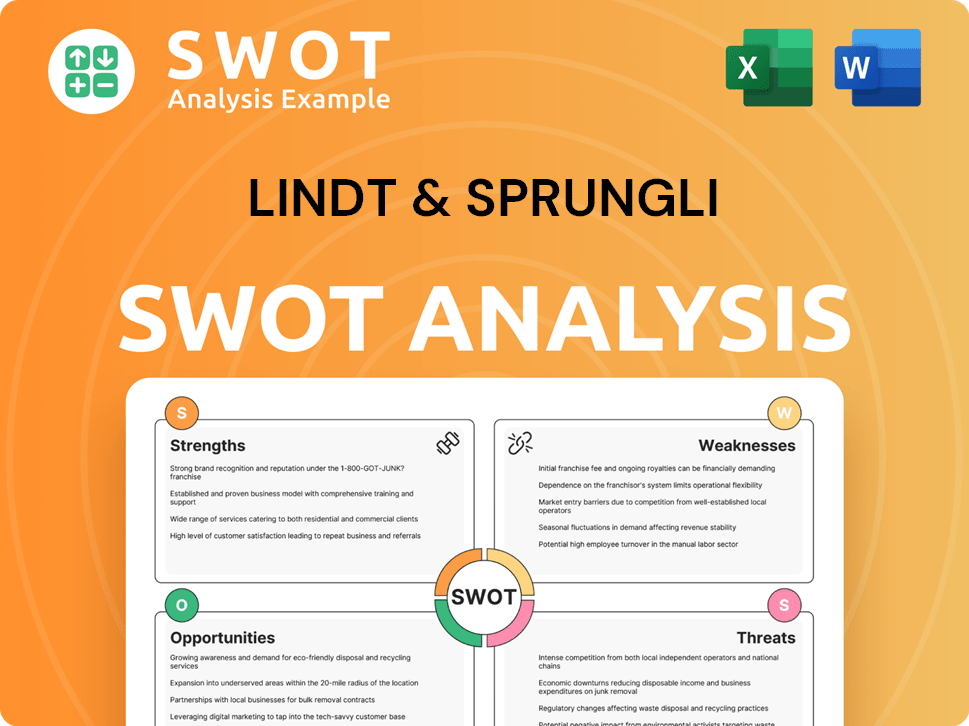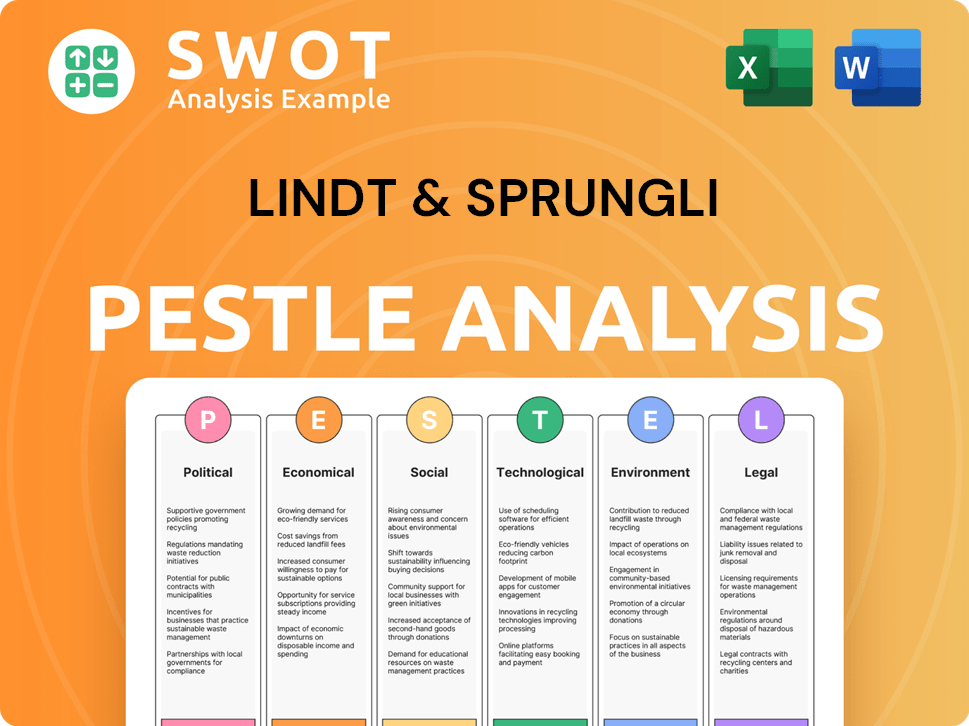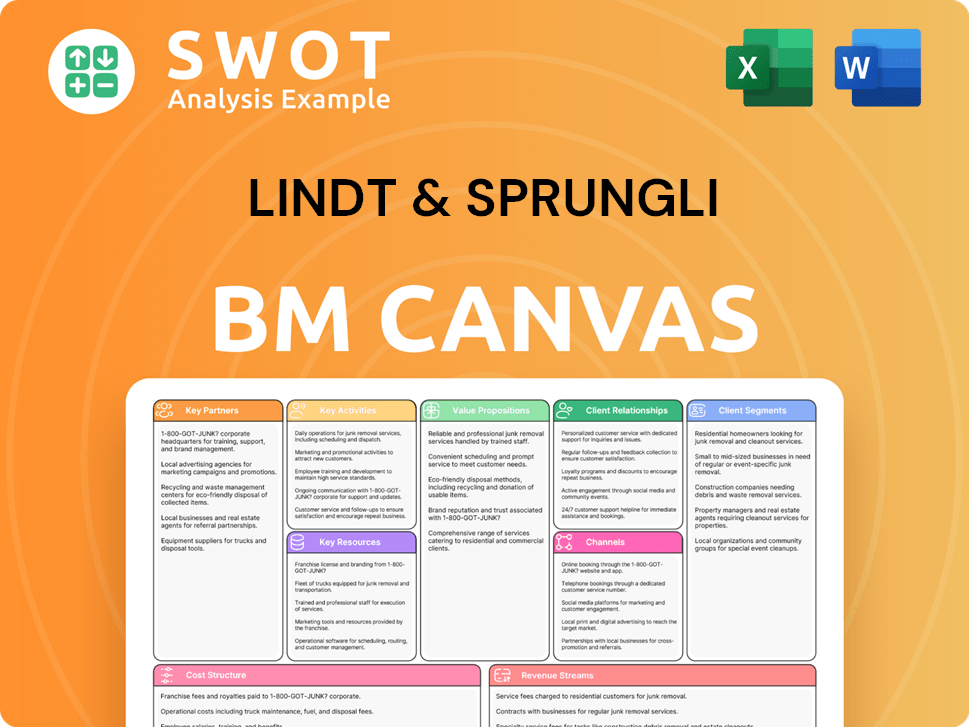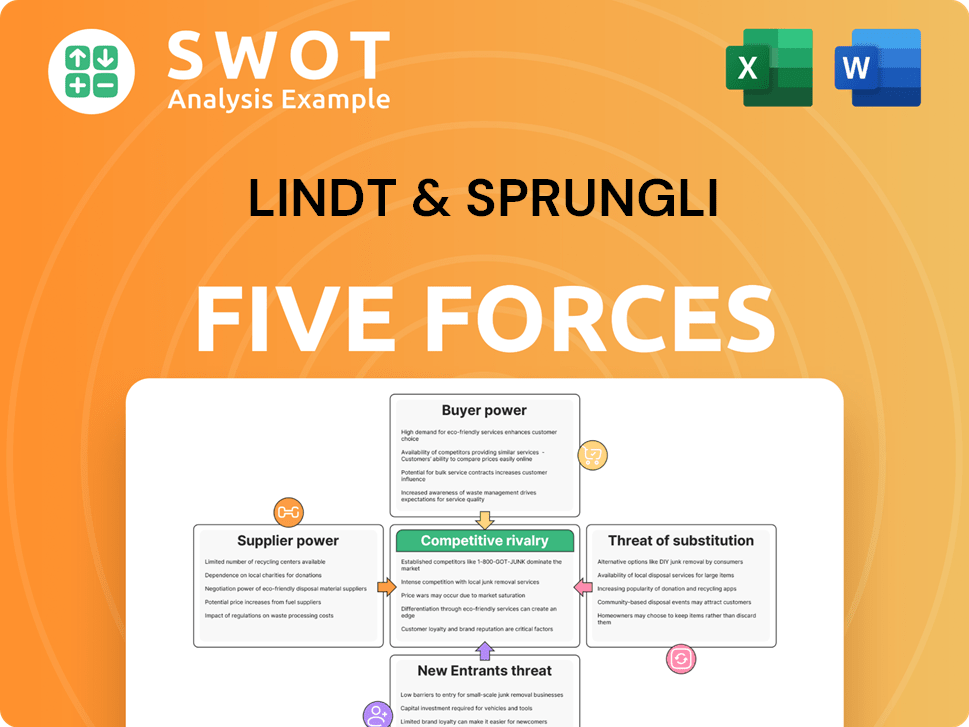Lindt & Sprungli Bundle
How did Lindt & Sprüngli become a global chocolate icon?
Journey into the delectable past of Lindt & Sprüngli, where a simple confectionery shop blossomed into a global chocolate empire. The Lindt & Sprungli SWOT Analysis reveals the strategies behind their success. From its Swiss origins to its worldwide presence, discover the key moments that shaped this iconic brand. Uncover the secrets behind their enduring appeal and the innovations that set them apart.

The story of Lindt & Sprüngli is a testament to the power of innovation and quality. From the early days of Swiss chocolate making to its current status as a leading chocolatier, the company's history is filled with fascinating milestones. Explore the brief history of Lindt & Sprüngli and understand how they revolutionized chocolate manufacturing and expanded globally. This exploration will uncover the early Lindt chocolate factories, and the impact of Lindt & Sprüngli on the chocolate industry.
What is the Lindt & Sprungli Founding Story?
The story of the Lindt & Sprungli history began in 1845. David Sprüngli-Schwarz and his son, Rudolf Sprüngli-Ammann, launched their confectionery business in Zurich, Switzerland. This marked the genesis of what would become a global chocolate powerhouse. The Sprünglis saw an opportunity to produce chocolate on a larger scale, setting the stage for the future of Swiss chocolate.
Their initial focus was on a small confectionery shop, producing solid chocolates and other sweet treats. This early venture laid the groundwork for the company's future innovations and expansion. The early days were characterized by a commitment to quality and a drive to improve the chocolate-making process, which would eventually set them apart.
One of the initial challenges was the texture of the chocolate. The opportunity lay in enhancing the quality and taste of the chocolate. Their early products likely included solid chocolate bars and various chocolate confections. The company name came from the founders' surnames, a common practice for businesses at the time. Initial funding probably came from self-funding or family resources, typical for small businesses in the mid-19th century. Switzerland's growing reputation for dairy and precision provided fertile ground for a refined chocolate industry.
Lindt & Sprungli SWOT Analysis
- Complete SWOT Breakdown
- Fully Customizable
- Editable in Excel & Word
- Professional Formatting
- Investor-Ready Format

What Drove the Early Growth of Lindt & Sprungli?
The early growth of the company, now known as the company, was marked by a dedication to quality and a gradual expansion of its operations. After its founding in 1845, the company steadily built its reputation in Zurich. A crucial moment in its early history was the acquisition of Rodolphe Lindt's chocolate factory in Bern in 1899. This acquisition brought the revolutionary 'conching' process, invented by Lindt in 1879, which produced the smooth, melt-in-your-mouth chocolate that became a hallmark of the brand.
The company expanded its product range beyond basic chocolate bars, introducing more refined confections. This expansion was driven by the positive market reception of their superior quality chocolate. The company began to establish a presence beyond Switzerland, entering international markets through exports. The increasing demand for their premium chocolate necessitated growth in production capacity and workforce.
The company's early international expansion involved exporting its products to various markets. While specific early sales figures are not readily available, the demand for their premium chocolate led to increased production. The company's commitment to innovation, particularly the conching process, provided a significant competitive advantage. This period saw the company solidify its position as a producer of high-quality, premium chocolate, laying the groundwork for its future global expansion. Learn more about the Target Market of Lindt & Sprungli.
The competitive landscape included other Swiss chocolate makers, but the company's commitment to innovation, especially the conching process, provided a significant advantage. This innovation allowed the company to differentiate its products and cater to a growing consumer preference for high-quality chocolate. This focus on quality and innovation helped the company establish a strong brand reputation.
While specific early sales milestones and initial team expansion figures are not readily available, the increasing demand for their premium chocolate necessitated growth in production capacity and workforce. The early success of the company set the stage for future growth. The company's focus on quality and innovation helped it solidify its position as a leading producer of premium chocolate.
Lindt & Sprungli PESTLE Analysis
- Covers All 6 PESTLE Categories
- No Research Needed – Save Hours of Work
- Built by Experts, Trusted by Consultants
- Instant Download, Ready to Use
- 100% Editable, Fully Customizable

What are the key Milestones in Lindt & Sprungli history?
The Lindt & Sprüngli history is marked by significant achievements that have shaped the Swiss chocolate industry. From its origins to its current global presence, the company's journey reflects a commitment to quality and innovation. The Lindt chocolate history is a story of consistent growth and adaptation within the competitive world of chocolate manufacturing.
| Year | Milestone |
|---|---|
| 1845 | David Sprüngli-Schwarz and his son Rudolf Sprüngli-Ammann open a confectionery shop in Zurich, Switzerland, laying the foundation for the future company. |
| 1879 | Rodolphe Lindt invents the conching process, revolutionizing chocolate manufacturing by creating a smoother, more refined texture. |
| 1899 | Sprüngli acquires Lindt's factory, combining the innovative conching process with Sprüngli's existing confectionery business. |
| 1952 | The Lindt gold bunny is introduced, becoming one of the company's most iconic and recognizable products. |
| 1994 | Lindt & Sprüngli expands its global presence by entering the US market. |
| 1998 | The acquisition of Ghirardelli expands its market reach, particularly in North America. |
| 2014 | The acquisition of Russell Stover further strengthens its position in the North American market. |
Lindt & Sprüngli's success is rooted in its continuous innovation in chocolate making. The conching process, a pivotal innovation, is still a key element in producing the smooth texture of Lindt chocolate. The company has consistently developed new products and packaging to meet evolving consumer preferences.
Rodolphe Lindt's conching process in 1879 was a groundbreaking innovation. This technique kneaded liquid chocolate, removing bitterness and creating a smooth texture, fundamentally changing chocolate manufacturing.
The company consistently innovates in product development. This includes new flavors, formats, and seasonal offerings to cater to diverse consumer tastes and preferences.
Lindt & Sprüngli is known for its attractive and innovative packaging. This includes the iconic gold bunny and other packaging designs that enhance brand recognition and appeal.
The company focuses on sustainable sourcing initiatives. This involves collaborations with cocoa farmers to ensure ethical and environmentally responsible practices in the supply chain.
Lindt & Sprüngli has expanded its global footprint. This includes strategic acquisitions and partnerships to reach new markets and increase its international presence.
The company focuses on brand building through marketing and advertising. This includes campaigns that highlight the quality and craftsmanship of Lindt chocolate.
Despite its successes, Lindt & Sprüngli has faced several challenges. Economic downturns and fluctuating cocoa prices have impacted the chocolatier. Maintaining a consistent supply of high-quality cocoa beans in an ethical and sustainable manner remains a key concern.
Economic fluctuations can affect consumer spending on premium goods. This necessitates strategic adjustments and a focus on value to maintain sales.
Fluctuating cocoa prices can impact profitability. The company must manage costs effectively and hedge against price risks to maintain margins.
The confectionery market is highly competitive, requiring continuous innovation and differentiation. This includes efforts to maintain brand loyalty and attract new customers.
Ensuring a consistent supply of high-quality cocoa beans is a challenge. This involves managing risks related to environmental and social factors in cocoa-producing regions.
Consumer preferences are constantly evolving, with demand for healthier options and ethical sourcing growing. This requires adapting product offerings and marketing strategies.
Geopolitical instability can disrupt supply chains and impact market access. This requires careful monitoring and proactive risk management strategies.
For example, in 2023, Lindt & Sprüngli reported sales of CHF 5.23 billion, a growth of 6.5% in local currencies. The company's strategy includes a focus on premiumization and innovation to drive growth. The company's commitment to sustainability is further detailed in Mission, Vision & Core Values of Lindt & Sprungli, which outlines its approach to ethical sourcing and environmental responsibility.
Lindt & Sprungli Business Model Canvas
- Complete 9-Block Business Model Canvas
- Effortlessly Communicate Your Business Strategy
- Investor-Ready BMC Format
- 100% Editable and Customizable
- Clear and Structured Layout

What is the Timeline of Key Events for Lindt & Sprungli?
The Lindt & Sprungli history is a story of innovation and global expansion, starting with a small confectionery shop in Switzerland and evolving into a worldwide leader in premium chocolate. From the invention of the conching process to the creation of iconic products like the Lindor truffle and the Gold Bunny, the company has consistently set the standard for Swiss chocolate and chocolate manufacturing. Strategic acquisitions, such as Ghirardelli and Russell Stover, have broadened its market presence, while investments in retail experiences and sustainable sourcing reflect its commitment to both quality and responsibility. The company's journey showcases its ability to adapt and thrive in a competitive market.
| Year | Key Event |
|---|---|
| 1845 | David Sprüngli and his son Rudolf Sprüngli open a confectionery shop in Zurich, Switzerland. |
| 1879 | Rodolphe Lindt invents the conching process, revolutionizing chocolate production. |
| 1899 | Sprüngli acquires Rodolphe Lindt's chocolate factory, forming 'Lindt & Sprüngli.' |
| 1949 | The iconic Lindt Gold Bunny is introduced for Easter. |
| 1967 | The first Lindor truffle is created, becoming a global sensation. |
| 1998 | Lindt & Sprüngli acquires Ghirardelli Chocolate Company, expanding its presence in the North American market. |
| 2009 | The company opens its first Lindt Chocolate Cafe in Sydney, Australia, expanding its retail experience. |
| 2014 | Lindt & Sprüngli acquires Russell Stover Chocolates, further strengthening its position in the U.S. market. |
| 2020 | The Lindt Home of Chocolate museum opens in Kilchberg, Switzerland, celebrating its heritage. |
| 2023 | Lindt & Sprüngli reports an organic sales growth of 10.3% and an operating profit (EBIT) of CHF 881.9 million. |
| 2024 | The company continues to focus on sustainable cocoa sourcing, aiming for 100% traceable and verified cocoa by 2025. |
Lindt & Sprüngli aims for an organic sales growth of 6% to 8% in 2024. They are focused on expanding their global retail network and investing in e-commerce channels. Innovation in new product development will also be a key initiative.
In 2023, the company demonstrated strong financial performance with an operating profit (EBIT) of CHF 881.9 million. The company is targeting an operating profit margin of 15% to 16% in 2024. This indicates a commitment to continued profitable growth.
A core focus is on sustainable cocoa sourcing, with a goal of 100% traceable and verified cocoa by 2025. This commitment addresses the increasing consumer demand for ethically sourced products. The company is also investing in sustainable chocolate manufacturing.
Lindt & Sprüngli is responding to the growing consumer interest in premium and healthier options. The company is also focused on innovation in chocolate making. These strategies position the company to maintain its leadership in the Swiss chocolate industry.
Lindt & Sprungli Porter's Five Forces Analysis
- Covers All 5 Competitive Forces in Detail
- Structured for Consultants, Students, and Founders
- 100% Editable in Microsoft Word & Excel
- Instant Digital Download – Use Immediately
- Compatible with Mac & PC – Fully Unlocked

Related Blogs
- What is Competitive Landscape of Lindt & Sprungli Company?
- What is Growth Strategy and Future Prospects of Lindt & Sprungli Company?
- How Does Lindt & Sprungli Company Work?
- What is Sales and Marketing Strategy of Lindt & Sprungli Company?
- What is Brief History of Lindt & Sprungli Company?
- Who Owns Lindt & Sprungli Company?
- What is Customer Demographics and Target Market of Lindt & Sprungli Company?
Disclaimer
All information, articles, and product details provided on this website are for general informational and educational purposes only. We do not claim any ownership over, nor do we intend to infringe upon, any trademarks, copyrights, logos, brand names, or other intellectual property mentioned or depicted on this site. Such intellectual property remains the property of its respective owners, and any references here are made solely for identification or informational purposes, without implying any affiliation, endorsement, or partnership.
We make no representations or warranties, express or implied, regarding the accuracy, completeness, or suitability of any content or products presented. Nothing on this website should be construed as legal, tax, investment, financial, medical, or other professional advice. In addition, no part of this site—including articles or product references—constitutes a solicitation, recommendation, endorsement, advertisement, or offer to buy or sell any securities, franchises, or other financial instruments, particularly in jurisdictions where such activity would be unlawful.
All content is of a general nature and may not address the specific circumstances of any individual or entity. It is not a substitute for professional advice or services. Any actions you take based on the information provided here are strictly at your own risk. You accept full responsibility for any decisions or outcomes arising from your use of this website and agree to release us from any liability in connection with your use of, or reliance upon, the content or products found herein.